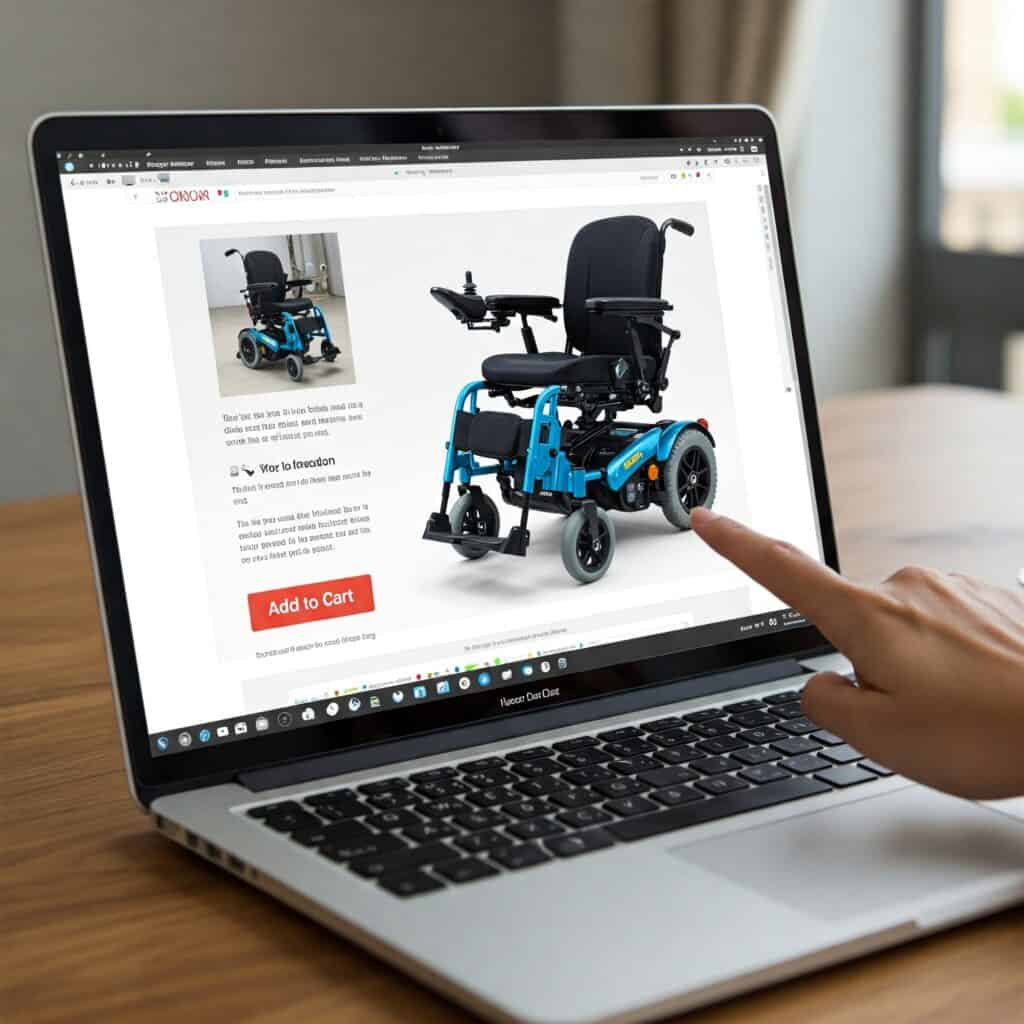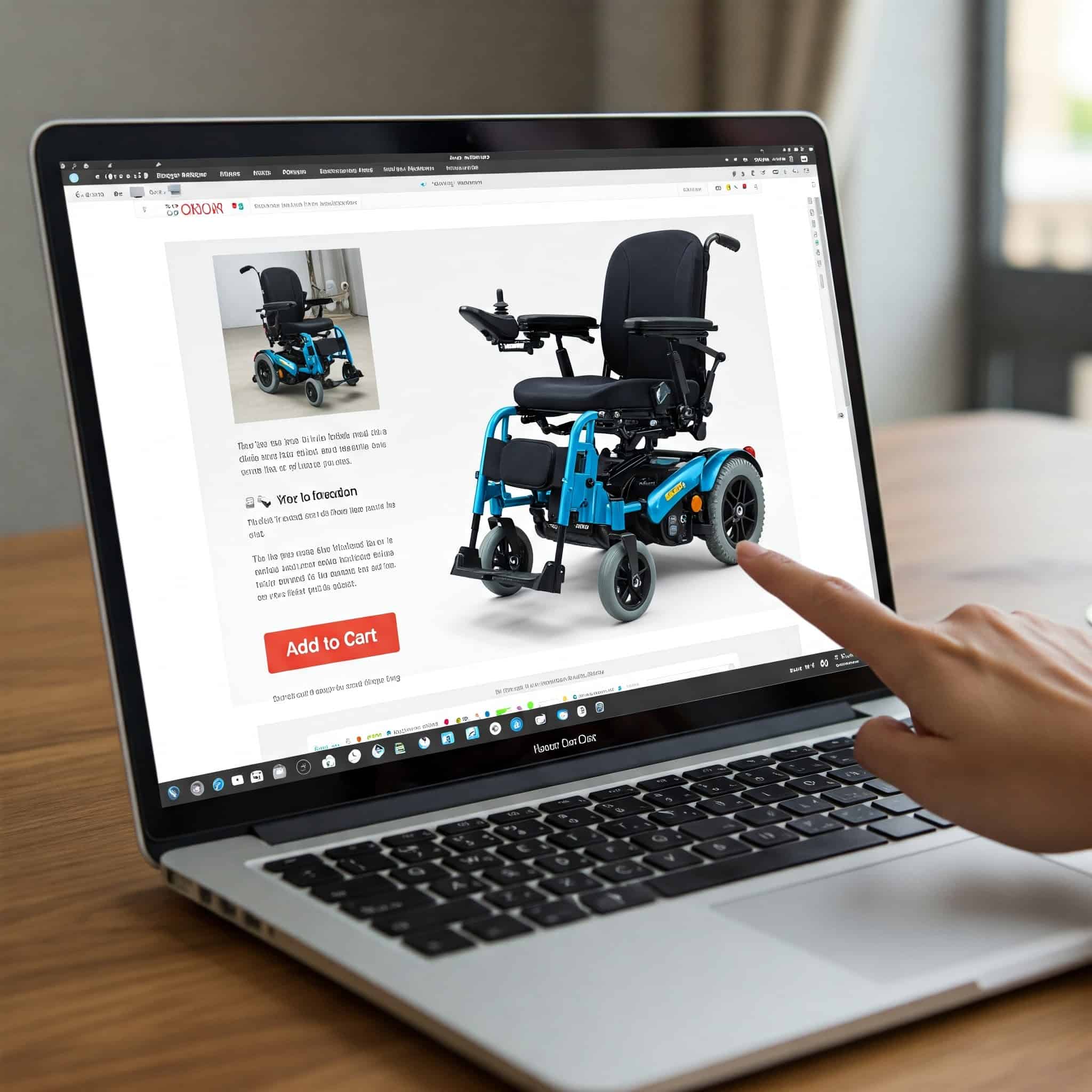Whether you are buying a power wheelchair online or at a brick and mortar store it is a big decision, impacting everything from your daily mobility to your overall quality of life. While online shopping offers convenience, navigating the world of electric wheelchairs requires more than just a few clicks. Unlike ordering a new pair of shoes, purchasing medical equipment like a power wheelchair online presents unique challenges. Buying a power wheelchair online isn’t just about finding the best deal; it’s about finding the right wheelchair for your specific needs. This article provides ten essential tips to guide you through a successful online power wheelchair purchase, ensuring you prioritize safety, comfort, and ultimately, independence.

Tip 1: Prioritize In-Person Evaluation
Before you even think about browsing online retailers, your first step in buying a power wheelchair should always be an in-person evaluation with a qualified occupational therapist (OT) or physical therapist (PT). This crucial step lays the foundation for a successful purchase, ensuring not only the right fit but also the safest and most effective mobility solution for your individual needs. Skipping this step is like building a house without a blueprint – it might look okay at first, but it’s likely to have serious problems down the road.
The Importance of Professional Assessment:
A qualified OT or PT brings specialized knowledge and experience to the table. They’ll conduct a thorough assessment of your physical abilities, limitations, and specific mobility challenges. This evaluation goes beyond simply measuring your height and weight. They’ll assess your muscle strength, range of motion, posture, balance, and any existing medical conditions that might impact your wheelchair use. This comprehensive assessment will guide the selection of the appropriate wheelchair type, features, and customizations.
Guiding Wheelchair Selection and Ensuring Proper Fit:
The OT or PT will use the information gathered during the evaluation to recommend the most suitable type of power wheelchair for you. This might include anything from a standard power wheelchair for everyday use to a more specialized model designed for complex needs or specific terrains. Proper fit is paramount. A wheelchair that’s too large or too small can lead to discomfort, pressure sores, and even safety hazards. The therapist will take precise measurements to ensure the seat width, depth, and height are optimized for your body, promoting proper posture and preventing potential complications.
Addressing Safety Concerns:
Safety is a top priority when choosing a power wheelchair. The in-person evaluation allows the OT or PT to identify any potential safety risks based on your individual circumstances. They can assess your ability to operate the wheelchair safely, considering factors such as your vision, cognitive function, and reaction time. They can also provide training on safe wheelchair operation, including maneuvering in different environments, transferring in and out of the chair, and proper maintenance.
Preparing for Your Evaluation with Online Research:
While the in-person evaluation is essential, you can make the most of your appointment by doing some preliminary research online. Familiarize yourself with the different types of power wheelchairs available (standard, lightweight, heavy-duty, etc.), as well as common features and specifications. Understanding basic terminology related to power wheelchair technology will help you ask informed questions and actively participate in the decision-making process. This preparation, combined with the expertise of your therapist, will empower you to choose the perfect power wheelchair to enhance your mobility and independence.
Tip 2: Conduct a Thorough Needs Assessment
Before you even browse online retailers, a comprehensive needs assessment is crucial. A power wheelchair isn’t a one-size-fits-all purchase; it’s a highly personalized piece of assistive technology. Understanding your individual requirements will ensure you select a wheelchair that enhances your mobility and independence, rather than creating new challenges. Consider the following key factors:
- Primary Use (Indoor, Outdoor, or Both): Where will you primarily be using your power wheelchair? Indoor use often prioritizes maneuverability and a tight turning radius for navigating tight spaces. Outdoor use demands greater ground clearance, robust suspension, and larger wheels to handle varied terrain. If you need a chair for both, look for models that balance these features. This will greatly influence your electric wheelchair selection.
- Terrain Encountered (Even/Uneven Surfaces, Ramps, Stairs): Think about the types of surfaces you’ll encounter daily. Will you be navigating smooth sidewalks, cobblestone streets, or grassy areas? Are there ramps or inclines you’ll need to climb? Understanding the terrain will help you choose appropriate wheel types, suspension options, and motor power. Consider the climbing ability of the wheelchair, especially if you frequently encounter inclines or curbs.
- Typical Driving Distances: How far do you typically travel in a day? This will directly impact your battery life requirements. Longer distances necessitate a battery with a higher amp-hour (Ah) rating. Don’t underestimate your typical usage; it’s better to have a battery with extra capacity than to run out of power mid-journey.
- Weight Capacity and User Weight: This is a critical safety consideration. Ensure the power wheelchair’s weight capacity comfortably exceeds your weight. Exceeding the weight limit can compromise the chair’s performance, damage components, and even pose a safety risk.
- Specific Mobility Challenges and Goals: Consider your unique mobility challenges and what you hope to achieve with a power wheelchair. Are you looking for increased independence in completing daily tasks? Do you need specific features to accommodate physical limitations? Clearly defining your goals will help you narrow down your options and choose a wheelchair that truly meets your needs. This personalized approach is key to a successful power wheelchair buying guide.

Tip 3: Measure Carefully – The Foundation of a Comfortable and Safe Ride
Accurate measurements are absolutely crucial when buying a power wheelchair online. A wheelchair that’s too big or too small can lead to discomfort, pressure sores, and even safety hazards. Think of it like buying a suit – you wouldn’t just guess your size! Taking the time to measure both yourself and your environment will ensure a proper fit and optimal maneuverability. This is a critical step in ensuring your electric wheelchair selection is perfect for your needs.
- Body Measurements: Start by measuring your body. This includes your seat width (the widest point across your hips or thighs while seated), seat depth (from the back of your knee to your buttocks), and seat height (from the floor to the back of your knee). These measurements will determine the appropriate seat dimensions for your power wheelchair, contributing to proper posture and weight distribution.
- Home Environment Measurements: Don’t forget to measure your home environment! This is just as important as measuring yourself. Measure the width of doorways, hallways, bathroom entrances, and any other tight spaces you’ll need to navigate. This will help you choose a wheelchair with a turning radius that allows you to move freely within your home. Consider the narrowest point you’ll encounter – this is your limiting factor.
- Checklist of Measurements: Create a checklist of all the essential measurements. Beyond those mentioned above, consider the overall width and length of the wheelchair itself, especially if you plan to store it in a specific area. Also, measure the height of any thresholds or ramps you’ll need to traverse. This comprehensive approach will help you avoid any surprises once your new power wheelchair arrives.
- Measuring Guides and Templates: If you’re unsure about how to take accurate measurements, look for online measuring guides or templates specifically designed for wheelchair fitting. These resources can provide step-by-step instructions and visual aids to ensure you get the correct dimensions. Some manufacturers or retailers may even offer virtual consultations to assist with this process. This ensures that your wheelchair features and specifications align with your measurements for optimal comfort and safety.
Tip 4: Research Key Features
Beyond the basic measurements and fit, understanding the specific features of a power wheelchair is crucial for maximizing its functionality and your comfort. Don’t just focus on the aesthetics; delve into the technical specifications to ensure the chair meets your lifestyle and mobility needs. Here’s a breakdown of essential features to research:
Climbing Ability (Inclines and Curbs): If your environment includes inclines or curbs, check the wheelchair’s climbing ability specifications. This indicates the maximum slope the chair can safely ascend. Ensure the chosen wheelchair can handle the inclines you’ll regularly encounter, both indoors and outdoors. Consider the height of curbs you might need to navigate; some wheelchairs are designed to handle small curbs, while others may require assistance. Understanding these limitations is crucial for safety and avoiding potential accidents.
Turning Radius: This measurement indicates how much space the wheelchair needs to make a complete turn. A smaller turning radius is essential for navigating tight spaces indoors, like hallways and bathrooms. If your home or frequently visited locations have narrow doorways or limited maneuverability, prioritize a wheelchair with a tight turning radius. This will significantly impact your ease of use and independence within those environments.
Ground Clearance: Ground clearance refers to the distance between the lowest part of the wheelchair and the ground. Higher ground clearance is important if you plan to use the wheelchair outdoors on uneven terrain, as it helps prevent the chair from scraping or getting stuck on obstacles. Consider the typical surfaces you’ll encounter – sidewalks, gravel paths, or grassy areas – and choose a ground clearance that can handle them. Insufficient ground clearance can lead to damage to the wheelchair and a bumpy, uncomfortable ride.
Suspension Options: Just like a car, the suspension system on a power wheelchair impacts the smoothness of the ride. Different suspension options are available, from basic to more advanced systems that absorb shocks and vibrations. If you anticipate traveling over rough or uneven surfaces, investing in a wheelchair with a good suspension system is crucial for comfort and preventing potential back or joint pain. A smoother ride also contributes to better control and stability.
Seat and Backrest Comfort and Adjustability: Since you’ll likely be spending considerable time in your power wheelchair, comfort is paramount. Research the different seat and backrest options available, considering factors like cushioning, adjustability (height, angle, recline), and breathability. Some models offer customizable seating systems to address specific postural needs or pressure relief requirements. Prioritizing comfort features can prevent pressure sores, fatigue, and discomfort during extended use.
Motor Power and Battery Life: The motor power determines the wheelchair’s speed and ability to handle inclines. Consider your typical driving distances and the terrain you’ll encounter. A more powerful motor is necessary for navigating hills or rougher terrain. Battery life is equally important; it determines how far you can travel on a single charge. Evaluate your daily mobility needs and choose a battery capacity that provides ample range to avoid being stranded.
Tip 5: Read Reviews Critically
User reviews can be a goldmine of information when choosing a power wheelchair. They offer insights into real-world experiences with different models, highlighting both strengths and potential weaknesses. However, it’s crucial to approach online reviews with a discerning eye. Not all reviews are created equal, and understanding how to filter and interpret them is key to making an informed decision about your electric wheelchair selection.
Focus on Relevant Feedback: Don’t just skim the star ratings. Delve into the content of the reviews and prioritize feedback that addresses factors directly related to your needs. Look for comments about durability – how well the wheelchair holds up over time – and comfort, especially regarding the seat, backrest, and armrests. Ease of use is also vital; consider reviews that discuss the controls, maneuverability, and overall user-friendliness. Finally, safety is paramount, so pay close attention to any reviews mentioning stability, braking, or potential safety concerns.
Identify Common Issues: One of the most valuable aspects of reading reviews is identifying recurring problems. If multiple users mention the same issue, such as a short battery life, difficulty navigating certain terrains, or problems with specific features, it’s a red flag worth investigating further. This can help you anticipate potential challenges and make a more informed comparison of different power wheelchair models.
Look for Detailed Explanations: Generic reviews like “Great wheelchair!” or “It’s okay” offer little value. Instead, seek out reviews that provide specific details. For example, a review that explains why the user finds the seat comfortable (e.g., “The adjustable backrest provides excellent lumbar support”) is much more helpful than a simple “comfortable” statement. Detailed reviews provide concrete examples and context, allowing you to better understand the user’s experience.
Be Wary of Biased Reviews: Unfortunately, some online reviews can be biased or even fake. Be cautious of reviews that are overly enthusiastic or lack specific details. Look for reviews that seem genuine and balanced, mentioning both positive and negative aspects. Reading reviews across multiple platforms can also help you get a more objective perspective. Consider reviews on retailer websites, forums dedicated to wheelchair users, and even social media groups related to disability equipment and assistive technology.
Consider the Reviewer’s Context: A review from someone who primarily uses their wheelchair indoors might not be as relevant as a review from someone who uses it outdoors on uneven terrain. Try to find reviewers whose needs and usage patterns are similar to yours. This will help you determine which reviews are most applicable to your situation.
Tip 6: Check Return Policies
Buying a power wheelchair online involves a degree of trust, as you can’t physically test the device before buying. This is why understanding the retailer’s return policy is absolutely crucial. A generous return policy can provide invaluable peace of mind, especially when dealing with medical equipment like power wheelchairs, where proper fit and functionality are paramount. Before finalizing your purchase, thoroughly investigate the return policy to avoid potential headaches down the road.
Importance of Generous Return Policies: A comprehensive return policy is your safety net. It allows you to return or exchange the power wheelchair if it doesn’t meet your needs or if you encounter unexpected problems. Perhaps the seat isn’t the right size, the controls are difficult to manage, or the chair simply isn’t suitable for your home environment. A good return policy acknowledges these possibilities and provides a clear process for returns or exchanges. It’s not just about getting your money back; it’s about ensuring you end up with a mobility device that truly works for you.
Comparing Return Policies Between Retailers: Don’t assume all online retailers have the same return policies. They can vary significantly, so it’s essential to compare them before making a purchase. Look for details like the timeframe for returns, any restocking fees, who pays for return shipping, and the condition in which the wheelchair must be returned. Some retailers might offer full refunds, while others might only offer store credit or exchanges. Don’t hesitate to contact customer service to clarify any ambiguities in the return policy. A little research upfront can save you a lot of frustration later.

Tip 7: Choose Reputable Sellers
Buying a power wheelchair online or in person is a significant investment, both financially and in terms of its impact on your mobility. Choosing the right seller is crucial to ensure a smooth and positive experience. A reputable seller not only offers quality products but also provides reliable customer service and support. Navigating the online marketplace can be tricky, so taking the time to research and verify seller credentials is essential. This section will guide you through the key aspects of choosing a reputable online power wheelchair retailer.
Buy from Reputable Online Retailers or Directly from Well-Known Manufacturers: Prioritize established online retailers specializing in medical equipment or, even better, purchasing directly from well-known power wheelchair manufacturers. Established businesses are more likely to have robust customer service systems, clear return policies, and a reputation to uphold. They often have dedicated teams to answer your questions and provide support throughout the buying process and beyond. Avoid purchasing from unknown or unverified sellers, especially those offering suspiciously low prices, as this could be a red flag for scams or substandard products.
Verify Seller Credentials: Before making a purchase, take the time to verify the seller’s credentials. Look for information about their business history, contact details, and any certifications or accreditations they may have. A legitimate seller will readily provide this information. Check if they are registered with relevant industry bodies or have positive reviews on independent consumer review platforms. A quick online search for the seller’s name can often reveal valuable information about their reputation and customer experiences.
Check Customer Service: A responsive and helpful customer service team is essential, especially when dealing with a complex purchase like a power wheelchair. Before you buy, test the seller’s customer service by asking questions about their products, return policy, or warranty. A prompt and informative response is a good indicator of their commitment to customer satisfaction. Consider contacting them via phone, email, or chat to assess their responsiveness and helpfulness.
Review Return Policies: A generous and clearly stated return policy is crucial, especially when buying a power wheelchair online. You might encounter fit issues, unexpected problems, or simply change your mind after receiving the product. A good return policy will allow you to return the wheelchair within a reasonable timeframe, provided it is in its original condition. Carefully review the seller’s return policy, paying attention to details like return shipping costs, restocking fees, and the process for initiating a return. Don’t hesitate to clarify any doubts or concerns with the seller before making a purchase. Understanding the return policy upfront can save you a lot of hassle and frustration down the line.
Tip 8: Inquire About Warranty and Support
Buying a power wheelchair online is a significant investment, and you want to ensure your investment is protected. A comprehensive warranty and readily available support can provide peace of mind and help you avoid unexpected costs or disruptions in mobility. Before finalizing your online purchase, thoroughly inquire about the warranty coverage and the support services offered by the seller. Understanding the specifics of the warranty and knowing where to turn for assistance can make a significant difference should any issues arise with your electric wheelchair.
Warranty Coverage: A solid warranty is crucial for protecting your power wheelchair. Inquire about the length of the warranty and what it covers. Does it cover all parts, including the motor, battery, and frame? Are there any exclusions or limitations to the coverage? Understand the process for making a warranty claim and what documentation is required. A longer warranty period generally indicates the manufacturer’s confidence in the product’s durability and quality. Don’t hesitate to ask for a copy of the warranty document to review carefully before making your purchase.
Availability of Repair or Replacement Parts: Knowing that replacement parts are readily available is essential for minimizing downtime should your power wheelchair require repairs. Inquire about the availability of common replacement parts, such as wheels, tires, batteries, and controllers. Are these parts readily available from the seller, or will you need to order them from a third-party supplier? Understanding the process for obtaining replacement parts can save you time and frustration in the future.
Local Service Centers and Trained Technicians: Having access to local service centers and trained technicians is invaluable for ongoing maintenance and repairs. Inquire whether the seller has authorized service centers in your area or if they can recommend qualified technicians. Knowing where to take your power wheelchair for servicing can streamline the repair process and ensure that the work is done correctly. Consider the proximity of these service centers to your home and their availability for appointments. This is a key aspect of power wheelchair maintenance and ensuring the longevity of your device.
Tip 9: Consider Accessibility Features
Choosing a power wheelchair is about more than just mobility; it’s about maximizing independence and comfort. A well-designed wheelchair with the right accessibility features can significantly impact your daily life. Think about how you’ll interact with the chair, how easily you can adjust it, and how it supports your specific needs. Here’s a breakdown of key accessibility features to consider:
Armrests and Footrests: Adjustable armrests are crucial for comfort and support, especially during extended use. Consider armrests that can be easily raised or lowered to facilitate transfers and allow you to get closer to tables or desks. Detachable armrests can be beneficial for side transfers or navigating narrow spaces. Similarly, adjustable footrests ensure proper leg positioning and can prevent discomfort or pressure sores. Consider elevating leg rests if you experience swelling or poor circulation.
Seat Elevation Options: A seat elevation feature allows you to raise or lower the seat height, which can be incredibly helpful for reaching items on higher shelves, interacting with people at eye level, and making transfers easier. This feature is particularly valuable for those who spend a significant amount of time in their power wheelchair. Think about the environments you’ll be in and whether the ability to adjust your seat height would enhance your experience.
Joystick Placement and Customization: The joystick is your primary control interface, so its placement and customization options are essential. Consider whether a right- or left-handed configuration is more comfortable for you. Some joysticks can be mounted in different locations, allowing for optimal control and accessibility. Also, inquire about the sensitivity and responsiveness of the joystick, as this can significantly impact your driving experience. A well-designed joystick should feel intuitive and easy to control, minimizing strain and maximizing maneuverability.
Tip 10: Factor in Transportation
Choosing a power wheelchair isn’t just about using it at home; you’ll likely need to transport it at some point. Thinking about how you’ll move your electric wheelchair is crucial for maintaining your independence and ensuring your new mobility device fits seamlessly into your life. From considering the wheelchair’s weight and folding mechanisms to evaluating vehicle compatibility, transportation logistics deserve careful consideration.
Wheelchair Weight and Folding Mechanisms: The weight of your power wheelchair significantly impacts how easily it can be transported. Consider who will be lifting and maneuvering the wheelchair, whether it’s you, a family member, or a caregiver. If frequent transport is anticipated, look for lightweight models or those with easily detachable components. Folding mechanisms are also essential. A power wheelchair that folds compactly can make a world of difference when it comes to fitting it into a vehicle or storing it when not in use. Consider how easily the chair folds and unfolds, and if it requires any specialized tools or assistance.
Vehicle Compatibility and Accessibility: Before purchasing a power wheelchair, carefully assess your vehicle’s compatibility. Measure the interior dimensions of your car, van, or SUV, paying close attention to the cargo space and the height and width of the opening. Consider whether you’ll need a ramp or lift to get the wheelchair into your vehicle. If so, factor in the weight and dimensions of the ramp or lift itself. For those using public transportation, research the accessibility features available on local buses or trains. Ensure that the power wheelchair meets the size and weight restrictions of the public transit system and that the routes you frequent are wheelchair accessible.
Transportation Options (Personal Vehicle, Public Transport): Think about the various transportation options you’ll utilize. Will you primarily be transporting the wheelchair in your personal vehicle? If so, ensure you have the appropriate vehicle modifications and securement devices to safely transport the wheelchair. Will you be relying on public transportation? If so, research the accessibility policies of your local transit authority and plan your routes accordingly. Consider also the availability and cost of paratransit services or other specialized transportation options for wheelchair users in your area. Planning your transportation strategy in advance will help you maintain your freedom and get the most out of your new power wheelchair.

Some Final Thoughts…
In conclusion, navigating the online marketplace for buying a power wheelchair online requires careful planning and informed decision-making. By prioritizing an in-person evaluation (Tip 1), conducting a thorough needs assessment (Tip 2), and taking accurate measurements (Tip 3), you lay a strong foundation for success. Researching key features (Tip 4), reading reviews critically (Tip 5), and understanding return policies (Tip 6) empower you to make confident choices. Choosing reputable sellers (Tip 7), inquiring about warranties and support (Tip 8), and considering accessibility features (Tip 9) ensure long-term satisfaction and peace of mind. Finally, factoring in transportation (Tip 10) allows your power wheelchair to truly integrate into your life.
Remember, the goal of buying a power wheelchair online is to enhance your independence, comfort, and safety. Don’t rush the process. Take your time, do your research, and consult with healthcare professionals. Your ideal power wheelchair is out there, waiting to help you live a more mobile and fulfilling life. One final piece of advice: document everything. Keep records of evaluations, measurements, feature preferences, and online interactions. This will be invaluable throughout your purchase journey and beyond.
Some Other Questions that People Also Ask
- How much does a power wheelchair cost? The cost of a power wheelchair can vary significantly depending on the type, features, and any customizations. Basic models can start around a few thousand dollars, while more advanced models with specialized features can cost upwards of ten thousand dollars or more. Consider your budget and explore potential funding options like insurance coverage or financial assistance programs.
- What are the different types of power wheelchairs? Power wheelchairs come in various types, including standard, lightweight, heavy-duty, and specialty models. Standard power wheelchairs are suitable for general use, while lightweight models are easier to transport. Heavy-duty models are designed for users with higher weight capacities or those who navigate rougher terrain. Specialty models cater to specific needs, such as standing wheelchairs or those designed for sports.
- Can I get a power wheelchair covered by insurance? Many insurance providers, including Medicare and private health insurance, may cover some or all of the cost of a power wheelchair if it’s deemed medically necessary. Coverage often depends on a physician’s prescription, a documented medical need, and meeting specific eligibility criteria. Contact your insurance provider to understand your coverage options and any necessary pre-authorization requirements.
- How do I choose the right battery for my power wheelchair? Choosing the right battery depends on factors like the wheelchair’s motor, your typical driving distances, and your charging habits. Battery capacity is measured in amp-hours (Ah), with higher Ah ratings generally providing longer driving ranges. Consider consulting with the wheelchair vendor or a healthcare professional to determine the appropriate battery type and capacity for your needs.
- What are the benefits of a power wheelchair with joystick controls? Joystick controls offer precise and intuitive maneuverability, making power wheelchairs easier to control, especially for individuals with limited hand dexterity or strength. Joysticks can often be customized to suit individual preferences and can be positioned for optimal comfort and accessibility.

